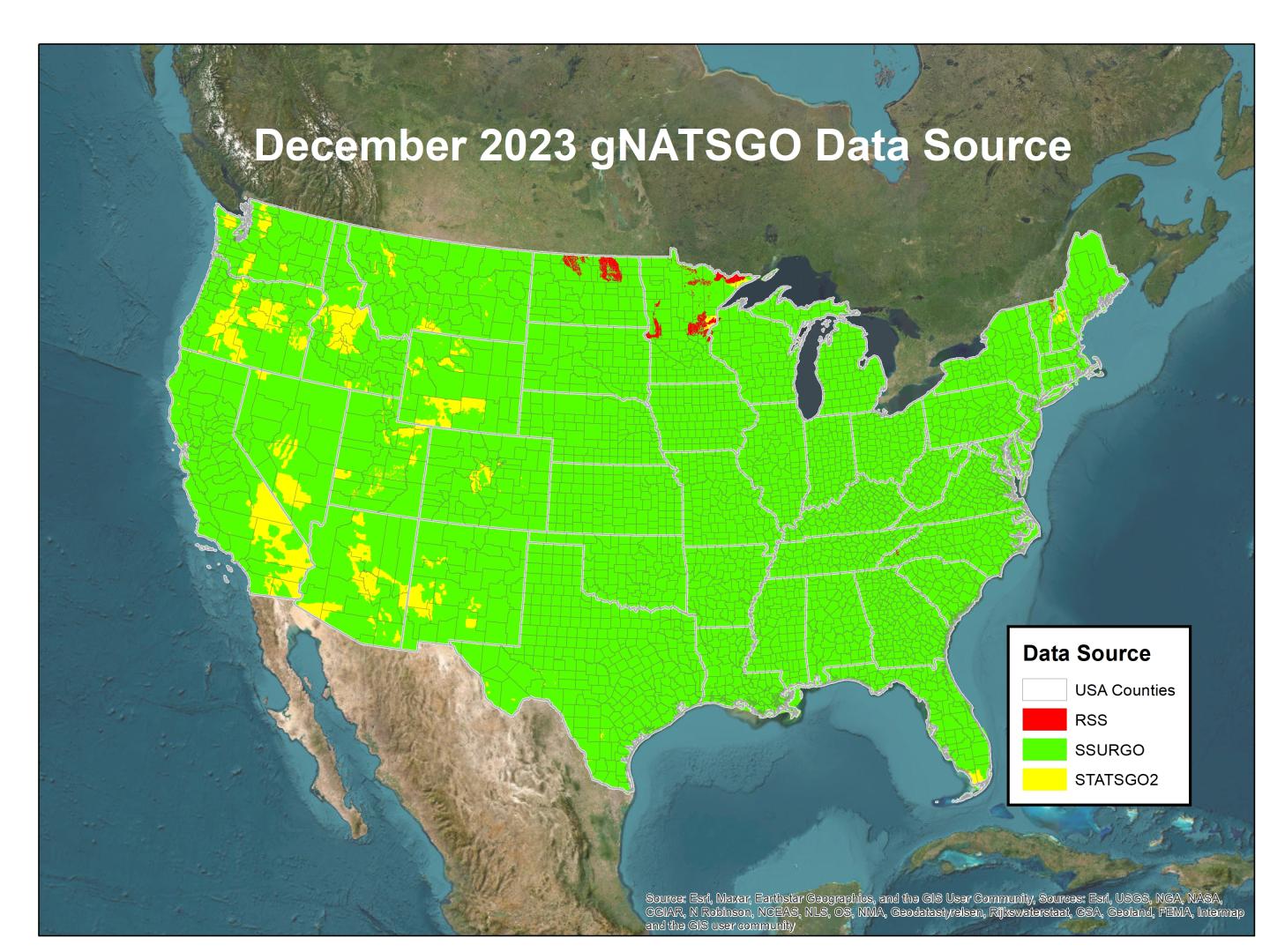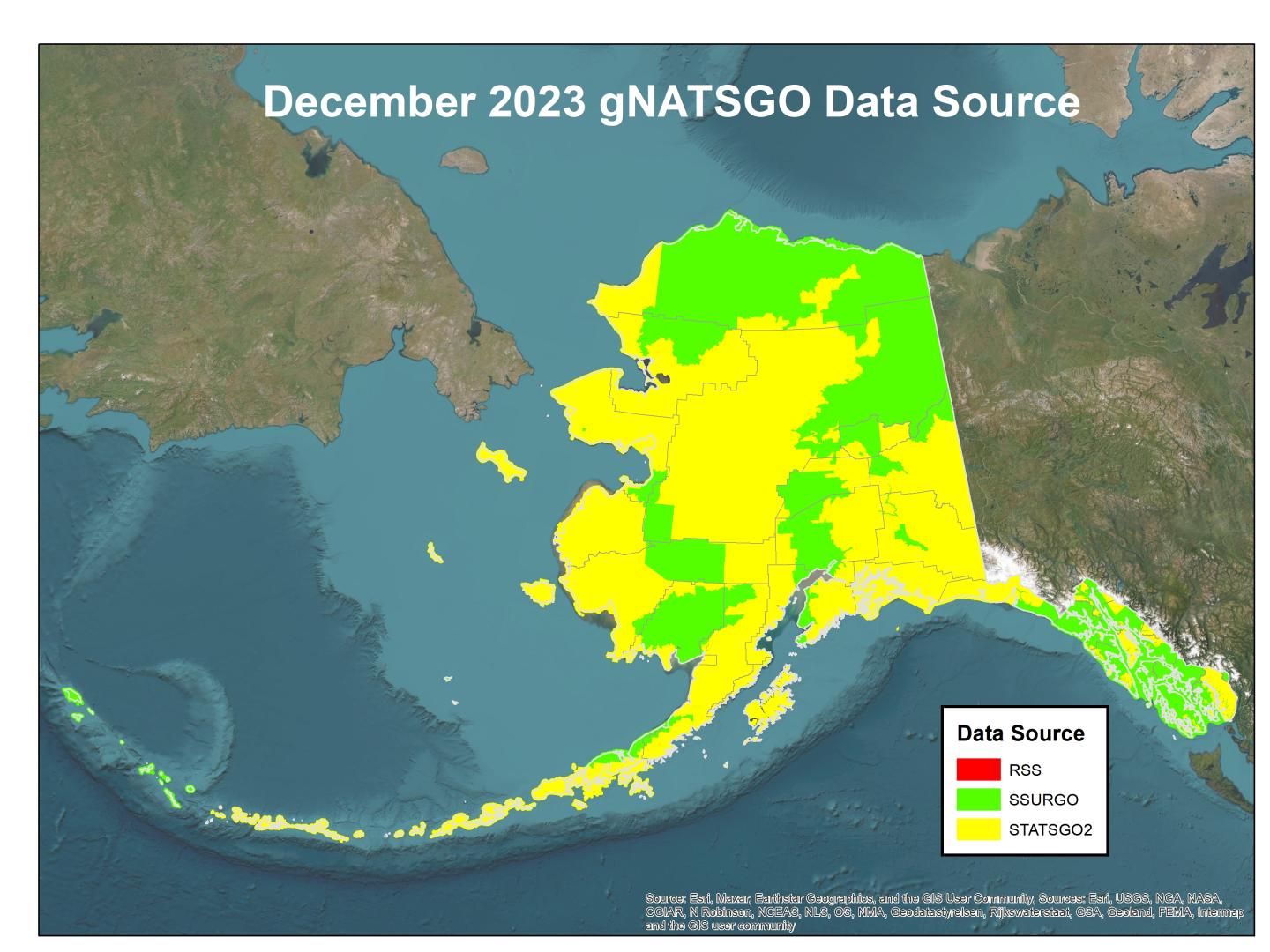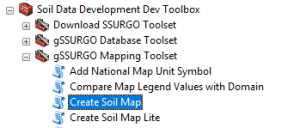Gridded National Soil Survey Geographic Database (gNATSGO)
The gridded National Soil Survey Geographic Database (gNATSGO) is a USDA-NRCS Soil & Plant Science Division (SPSD) composite database that provides complete coverage of the best available soils information for all areas of the United States and Island Territories.
Quick Links
Download Databases
Description
ArcTools for Working with gNATSGO
Create a Soil Property or Interpretation Grid
Metadata
Technical Information
Data Citations for gNATSGO
Download Databases
Description
The gridded National Soil Survey Geographic Database (gNATSGO) is a USDA-NRCS-SPSD composite database that provides complete coverage of the best available soils information for all areas of the United States and Island Territories. It was created by combining data from the Soil Survey Geographic Database (SSURGO), State Soil Geographic Database (STATSGO2), and Raster Soil Survey Databases (RSS) into a single seamless ESRI file geodatabase.
The gNATSGO databases are available for some individual states and island territories and for the conterminous United States (CONUS). Not all states have a gNATSGO database. For the individual states and island territories, gNATSGO was created only for those that have incomplete data in SSURGO or have an RSS.
If you require data for a state or island territory that does not have a gNATSGO database, you can download gSSURGO. Each state and island territory has a gSSURGO database.
The gNATSGO databases contain a rasterized version of the soil map units and 70 related tables of soil properties and interpretations. They are designed to work with the custom USDA-NRCS Soil Data Development ArcToolbox (See below for more information about the tools). Users can create full coverage thematic maps and grids of soil properties and interpretations for large geographic areas, such as the extent of a State or CONUS. Note, the custom tools currently only work in ArcGIS Desktop ArcMap. They do not currently work in ArcGIS Pro.
SSURGO is the SPSD flagship soils database that has over 100 years of field-validated detailed soil mapping data. SSURGO contains soils information for more than 90 percent of the United States and island territories, but unmapped land remains. Click here for the current completion status of SSURGO mapping. STATSGO2 is a general soil map that has soils data for all of the United States and island territories, but the data is not as detailed as the SSURGO data. The Raster Soil Surveys (RSSs) are the next generation soil survey databases developed using advanced digital soil mapping methods.
The gNATSGO database is composed primarily of SSURGO data, but STATSGO2 data was used to fill in the gaps. The RSSs are newer product with relatively limited spatial extent. These RSSs were merged into the gNATSGO after combining the SSURGO and STATSGO2 data. The extent of RSS is expected to increase in the coming years.
Figure 1 shows the distribution of SSURGO, STATSGO2, and RSSs in gNATSGO for CONUS. Limited SSURGO data is available for Alaska because of the size and difficulty in accessing many areas of the State. Figure 2 shows the distribution for Alaska. The State of Hawaii and all island territories, except Puerto Rico, have complete coverage in SSURGO.


Notes
- The USDA-NRCS-SPSD refreshes all published soil databases annually. gNATSGO will be included in the refresh cycle, which will provide a new up-to-date version of the database each year.
- gNATSGO is an ESRI file geodatabase.
- In the state and island territory databases, the soil map units are delivered only as a 10-meter raster version.
- In the CONUS database, the raster is 30-meter.
- No vectorized version of the soil map units is included in gNATSGO.
- The soil map units are uniquely identified by the mukey, which is included in the attribute table.
- The database has 70 tables that contain soil attributes, and relationship classes are built into the database to define relationships among tables.
- The raster can be joined to the Mapunit and Muaggatt tables in the MUKEY field.
- The database contains a feature class called SAPOLYGON. The “source” field in this feature class indicates whether the data was derived from SSURGO, STATSGO2, or an RSS.
- If you encounter an ArcMap error when working with a gNATSGO dataset that reads “The number of unique values exceeds the limit” try increasing the maximum number of unique values to render in your Raster ArcMap Options. Specific instructions can be obtained here: https://support.esri.com/en/technical-article/000010117
Download the Soil Data Development Toolkit (ZIP file).
Most customers will only need to use the Create Soil Map tool, which is in the gSSURGO Mapping Toolset.

The Create Soil Map tool replicates the functionality of Web Soil Survey and Soil Data Viewer. It allows users to create on-demand thematic maps of soil properties or interpretations with controls for aggregation method and depth.
Create a Soil Property or Interpretation Grid
These instructions explain how to convert the output of the Create Soil Map tool to a standalone grid that can be used in spatial analyses.
The create soil map tool is part of the Soil Data Development Toolbox (See above for more information about the tools). This tool replicates the functionality of Web Soil Survey and Soil Data Viewer. It allows users to create on-demand thematic maps of soil properties or interpretations with controls for aggregation method and depth. It analyzes the tables of soils information in the gNATSGO database and joins the results to the raster layer, outputting a temporary layer file. The following instructions show how to convert temporary custom thematic map layers to stand alone grids that can be used in spatial analyses.
Metadata
ArcGIS metadata is available for each table, grid, and feature class in the file geodatabase. Users can view metadata by navigating to and highlighting the database or table in the Contents of ArcCatalog and then clicking on the Description tab.
gNATSGO has a schema that is very similar to that of SSURGO and STATSGO2. Click on the following link for information about the gNATSGO database tables and columns.
Technical Information
To obtain technical information about the use of soils data, please contact your NRCS State Soil Scientist or the Soils Hotline Staff at 402-437-5379 (Tammy Cheever).
Data Citations for gNATSGO
State Tile
Soil Survey Staff. Gridded National Soil Survey Geographic (gNATSGO) Database for State name. United States Department of Agriculture, Natural Resources Conservation Service. Available online at https://nrcs.app.box.com/v/soils. Month, day, year (FYyear official release).
Conterminous U.S. Tile
Soil Survey Staff. Gridded National Soil Survey Geographic (gNATSGO) Database for the Conterminous United States. United States Department of Agriculture, Natural Resources Conservation Service. Available online at https://nrcs.app.box.com/v/soils. Month, day, year (FYyear official release).
Citation Examples
The following examples are for the FY2020 gNATSGO dataset for the State of Texas. Such citations should appear in the reference section of your document.
State Tile
Soil Survey Staff. The Gridded National Soil Survey Geographic (gNATSGO) Database for Texas. United States Department of Agriculture, Natural Resources Conservation Service. Available online at https://nrcs.app.box.com/v/soils. December 19, 2023 (FY2024 official release).
Conterminous U.S. Tile
Soil Survey Staff. Gridded National Soil Survey Geographic (gNATSGO) Database for the Conterminous United States. United States Department of Agriculture, Natural Resources Conservation Service. Available online at https://nrcs.app.box.com/v/soils. December 19, 2023 (FY2024 official release).
Contact Soils
Please contact us if you see something that needs to be updated, if you have any questions, or if you need accessibility assistance.

